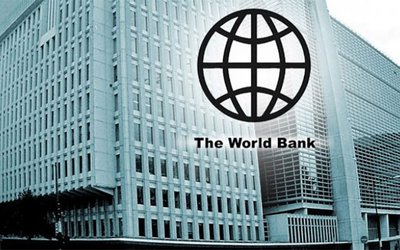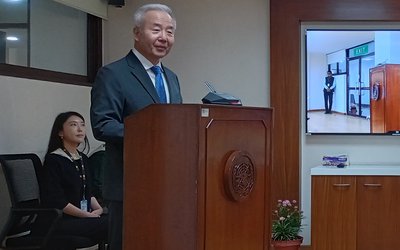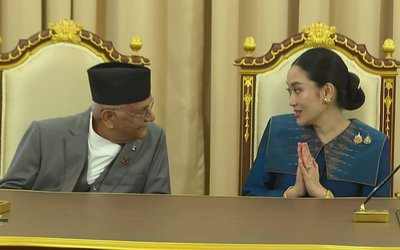
Presenting the budget on the eve of the federal election, the finance minister is trying to convince himself of the familiar accusation: he must be able to prove that it is not an election budget. How does the last budget of the finance minister answer this question? See the answer from Sir Humphrey's playbook: whether it is an election budget or not: it depends on your point of view.
The finance minister has stated that agricultural production program will be implemented in this budget. He said that a fund of Rs 5 trillion would be set up to invest in the agricultural sector through microfinance. Banks and financial institutions as well as citizen investment Trust and social security funds will have to invest in this fund.
Banks and financial institutions will have to deposit 5 percent in this fund and 10 percent in agriculture. Also presenting the forthcoming budget, the Finance Minister said that the production will be increased by using the barren land. The barren land will be made available to the agricultural cooperatives.
Agriculture program will be implemented for self-reliance. Rupees 5 billion has been allocated for this. The government has taken a policy to reduce the import of basic agricultural produce from the forthcoming budget. He said imports of paddy, maize, wheat and vegetables would be reduced by 30 per cent but it would be difficult to implement them without increasing production.
The message of the budget for our political economy is that it is still facing the challenge of being an economically responsible government. This is not for the elections to the House of Representatives, the National Assembly, the state assemblies, but it certainly seems to be for 2079/80. Ignoring limited resources and weak spending capacity, the government on brought in a budget 24 percent larger than the current year's revised budget for the coming fiscal year. Finance Minister unveiled a budget of Rs 1.798 trillion in a joint sitting of the federal parliament.
In the budget, provision has been made for program distribution, discounts and salary increase to affect the voters in the upcoming election.
Finance Minister had initially brought a budget of Rs 1.632 trillion for the current fiscal year. Later, it was amended to spend Rs 1.546 trillion through mid-term review. Stating that even that budget cannot be spent, he re-amended it and stated that only Rs. 1447.51 billion will be spent this year. While the amount is unlikely to be fully spent, an additional Rs 346.32 billion has been allocated for the next year.
For that, income and expenditure figures are impossible. The government has claimed that it will get revenue of Rs 1.24 trillion in next year's budget. The target is to get Rs. 256 billion from domestic debt, Rs. 242.26 billion from foreign debt and Rs. 55.46 billion from foreign grants. But former finance ministers and economists say that goal cannot be achieved.
The size of the budget has changed. The budget, which is about 38 percent of GDP, is still large.
Revenue targets, foreign loans and grants are unlikely to be met. Out of the budget allocated by Finance Minister, Rs. 753.40 billion is for current expenditure, Rs. 380.38 billion for capital expenditure, Rs. 230.22 billion for financial management and Rs. 429.83 billion for financial transfer at state and local level.
While the average age of Nepalis is increasing, the budget has made an arrangement to get old age allowance at the age of 68. There has been criticism that the age limit for receiving old age allowance has been increased. Under the social security program, the allowance has been provided to the senior citizens in the age group of 70 years and above.
Positive arrangements have also been made by the government to respect the beneficiaries who self-declare not to take social security allowance. The government has increased the salaries of all civil servants, including civil servants, army, police and teachers, by 15 percent. The current dearness allowance has also been given continuity.
Finance Minister has even slashed the income tax threshold that will directly affect the workers. Income tax exemption limit to 500,000 for natural persons and 600,000 for couples have been extended.
In order to provide relief to small entrepreneurs affected by the Covid-19 pandemic, 75 percent income tax exemption has been provided to the taxpayers with an annual turnover of up to Rs 3 million and 50 percent income tax exemption has been provided to the taxpayers with an annual turnover of Rs 3 million to 10 million.
Arrangement has been made to give 50 percent tax exemption on the commercial taxable income of the tourism sector industries such as hotels, travel, trekking and movie business which are most affected by the pandemic of Covid-19.
Similarly, provision has been made in the budget for deducting only 1.5 percent advance tax on authorship received as royalty for literary articles or works.
The budget has also proposed to distribute an electric stove to a family through local level. Improved stoves will be distributed to households without access to electricity under the smoke-free kitchen campaign. This approach has been appreciated by the opposition party as well.
The overall budget for next year is entitled 'Sustainability, Productivity and Employment Growth: Inclusive Development, Self-Reliance and Economic Prosperity'. In most of these areas, although the old ones continue, some new programs have been put forward for domestic production and import substitution.
For that, there are programs including priority in agriculture, guarantee of concessional loans, strictness in import of luxury goods, subsidy in export. The government is going to launch a special campaign 'Increase in Production: Development and Prosperity of the Country Decade (2079-089)'. The 'Prime Minister's Nepali Production and Consumption Growth Program' will be launched to increase Nepali production, create employment and increase export-oriented trade.
Necessary support will also be provided by the Government of Nepal to campaigns such as Make in Nepal and Made in Nepal run by the private sector.
In order to increase the contribution of industry sector to the Gross Domestic Product (GDP), it has been announced to build infrastructure for manufacturing industries and to facilitate the import of machinery and industrial raw materials. ‘Farmers will be encouraged to cultivate cash crops.
Impact on inflation
The effect of the program including low age of old age allowance, increase in salaries of employees, increase in tariff rate on imported goods has almost certainly been felt in price rise. Especially in the Nepali market, there is a tendency to increase the prices of various items in the market by looking at the old age allowance and salary fluctuations of the employees. Government policy on fuel and gas will also increase prices in all directions.
In the budget submitted by Finance Minister, it is mentioned that the subsidy on gas will be removed. Arrangements will be made to complete the remaining process related to investment approval and operation of the industry within six months.
In the budget, it is said that the private sector will be developed as the economic engine of the country. The government has decided to give two to 15 percent discount on the tariff of the industry which consumes more than Rs 100 million yearly of electricity .
The government has allocated Rs 3.45 billion for the "Entrepreneurship Decade" campaign. The limit for foreign investment has been reduced from 50 million to 20 million. In order to discourage small investment from neighboring countries, the limit of 50 million was kept and those who have reduced the limit for attracting foreign direct investment should be taken in a mixed manner.
It has announced approval of foreign investment of up to Rs 100 million will be done through automated system.
In other programs: Foreign nationals can also purchase units of apartments built by the government by the private sector. In order to manage the real estate business, the business will be done only through licensed companies and individuals. In the open and market economy, there are those who are of the view that the license rule should not be revived.
A “Janajati” Museum is to be set up in Kirtipur. There are 1.5 billion budget allocation programs In addition, old age allowance will be given to the citizens who have reached 68 years of age. Medicare services available under health insurance will no longer be available from private hospitals. The government will provide a free electric stove to a family through the local level. Nepal Electricity Authority is going to issue IPO at a premium We must also accept the definite middle class approach taken by this government to manage the economy. Of course, no finance minister can follow the basic principle of all our mothers to run the household: either spend less than you earn, or earn more than you spend. The most powerful economy runs at a loss. What is a populist budget? Every year on the 15th of Jeshta, the Finance Minister of Nepal presents the Union Budget in the Parliament. That budget is also called the Annual Financial Statement of Nepal, and it includes the details of revenue sources and expenditures to be made by the government in the current fiscal year. In other words, Nepal's central budget keeps the government's financial accounts for the coming fiscal year. It serves as the government's roadmap for fundraising and appropriation during this period. Importance of Federal Budget As Nepal is a democratic country, it is governed according to the constitution of Nepal. The constitution defines the role of the central government so that it can work effectively in the interest of its citizens. The government has many responsibilities, including the administration of the country, maintaining peace and order, ensuring national security, promoting social welfare, and improving economic stability. However, the government needs adequate resources and planning to accomplish these tasks. It collects revenue by taxing its citizens and can borrow from foreign countries and Nepal Rastra Bank. The government proposes a federal budget each year, which includes details of how and where the accumulated revenue is planned to be spent. The overall objective of the federal budget is to strike a balance between economic growth and overall development of the society. It aims to reduce economic inequality among citizens and ensure fair distribution of government resources. The plans that the government will achieve when presenting the federal budget are as follows: Effective allocation of resources to reduce unemployment and poverty and to reduce the cost of economic inequality in society should be examined. Budget. The populist budget is aimed at making the people happy while the progressive budget is aimed at economic growth
The populist budget is aimed at making the people happy while the progressive budget is aimed at strengthening economic growth. As mentioned above, the government always tries to keep the two in balance while presenting the federal budget. However, sometimes the budget can be more pro-democracy, especially as the general election approaches. Such a budget is called a democratic or election-oriented budget. Let's look at what a populist budget is and how it can affect the economy.
What is a populist budget?
As mentioned, a popular budget is usually to please the people. Such a budget spends more on attractive schemes that could increase the government's fiscal deficit and increase inflation. Examples of such schemes include waiver of agricultural loans, easing of existing tax structure, higher purchase price of agricultural produce, imposition of agricultural tax on rectangular agricultural commodities, increase of allowance for senior citizens, increase in salaries of employees, etc.
The positive side of a populist budget is that it can boost the market by increasing the demand for goods.
Impact on the economy
A popular budget revolves around the general concerns of the people. However, it does little to strengthen the country's overall economic growth. Such a budget would increase the pressure on the government and also increase the country's fiscal deficit. So it is not good for the economy. This is also the reason why economists often oppose popular budgets. Conclusion Although a populist budget can stimulate the market in the short term, it is not good for the country's long-term economic growth. Before elections, governments often present popular budgets to appease the general public. However, with proper planning and quality of expenditure, budgets can be made popular rather than democratic.
The issue of increasing the salary or benefits of civil servants and government employees may be relevant in time. As the size of the budget will be bigger than the budget of the current fiscal year, the tax rate and area will be expanded.
At the same time, the budget is bound to go into deficit. When the financial indicators are already negative, the deficit budget makes the situation worse.
Since the government has not been able to spend the capital budget for years, it is not known why each government brings a deficit budget every year. This shows that the government at that time was a little excited to increase the size of the budget. Thus, when a budget is announced without resources, aspirations increase but will not be fulfilled. Some private sectors have also welcomed the presentation of the budget for the current fiscal year, with a policy of transforming the economy based on imports and remittances into domestic production and domestic income-oriented economy.
The government has given priority to this issue in launching the 'Make in Nepal' and 'Made in Nepal' - Swadeshi 'campaign for the development of Nepal's industrialization and productive economy. The government has announced to reduce trade deficit by conserving indigenous products, identifying exportable and comparative advantage goods and increasing their competitiveness.
In the past, those in the government were in the opposition, criticizing the budget for distribution-oriented and unproductive sectors. Even this budget has not been able to give up the greed for distribution. For example, budget obligations that distribute cash are added. The age of old age allowance has also been reduced and there are some election-affecting programs.
The war between Ukraine and Russia, the negative economic indicators in Nepal, the local elections and the provincial and federal elections to be held in November, and the institutionalization of federalism in accordance with the provisions of the constitution, have to advance the agenda of economic development and prosperity. The common man is suffering from a lack of liquidity.
The government should inject liquidity into the system so that our country can move forward with a fast-moving economy based on consumption. The budget was expected to be extraordinary and unpredictable and uplifting so that it could be remembered as the budget of the decade.
- “Kolahalko Kolaj “: A Collection Of Scattered Memories By Prakash Sayami
- Apr 02, 2025
- Nepal-India Trade, Transit And Unauthorized Trade: Some Considerations
- Jan 16, 2025
- PM Oli’s Forthcoming Visit To China: Will The Achievement Be Complete?
- Nov 29, 2024
- Obituary To Dr. Mohan Man Sainju!
- Nov 02, 2024
- Donations To Political Parties: Some Reflections
- Oct 24, 2024















